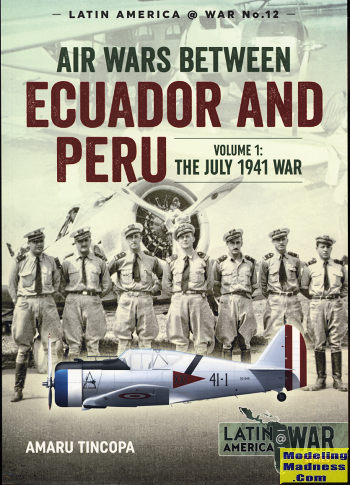 Helion has
made a reputation for itself by providing well researched books on the lesser
known conflicts around the world. South American was by no means isolated from
conflict and many nations had wars that were primarily based on border
disagreements. This is not as unusual as it might seem as often these disputed
areas were either highly mountainous or somewhere in the Amazonian jungle.
Helion has
made a reputation for itself by providing well researched books on the lesser
known conflicts around the world. South American was by no means isolated from
conflict and many nations had wars that were primarily based on border
disagreements. This is not as unusual as it might seem as often these disputed
areas were either highly mountainous or somewhere in the Amazonian jungle.
A case in point is the disagreement of Ecuador with its
larger southern neighbor Peru. Of the two, Peru was much more wealthy and so had
a considerable military and air force. Ecuador was originally fairly poor so
military expenditures were only a small percentage of what Peru couild afford.
However, Ecuador did spend its money wisely and got the best it could afford,
which was an armed trainer.
Conversely, Peru had a larger budget and was able to
purchase a fair number of bomber and fighter types from Italy during the 1930s.
They were even the largest user of the fighter version of the T-6, the
NA.50/P-64. Douglas was also successful in several South American nations with
sales of the then-modern 8A-3 attack bomber.
Attempts to make a permanent border fix fell apart in
mid 1941 and open warfare in the remote areas of eastern Ecuador/north-eastern
Peru broke out. Initially both sides used air power, but the Ecuadorans were
quickly overwhelmed by the larger Peruvian forces sent into the are. All
additional air power projection for the rest of the conflict was Peruvian as
Ecuador moved its air assets to cover the capital city.
This did not mean that things were one sided as Peru
lost a considerable number of aircraft to ground fire. Recall if you will that
armor plating was not something even the most modern planes of the time had
installed so it is easy to see how even rifle calibre bullets could cause fatal
damage. Work by several other nations put an end to the fighting on 31 July
1941, mostly in favor of Peru, creating a fairly large disputed area where
military forces were not allowed, however, history showed that was not the end
of things.
As is often the case in this series, the author has done
a magnificent job straightening everything out for the reader so that we can
follow not only the twists and turns on the ground, but also in the political
arena. While not as convoluted as those conflicts involving insurgencies,
politics plays a part in every war and it is important to see why each side did
what they did. When you add in the great period photos,
excellent charts and maps along with a nice selection of color work on the
aircraft involved, you have a book that makes for a great read.
This one is very much recommended to those who have an
interest in this sort of conflict or this part of the world. Pick it up. You
won't be disappointed.
June 2020
Copyright ModelingMadness.com. All rights reserved.
Review book courtesy of
Casemate Publishing, where you can order your copy
at this
link.
If you would like your product reviewed fairly and quickly, please
contact
me or see other details in the
Note to
Contributors.
 Helion has
made a reputation for itself by providing well researched books on the lesser
known conflicts around the world. South American was by no means isolated from
conflict and many nations had wars that were primarily based on border
disagreements. This is not as unusual as it might seem as often these disputed
areas were either highly mountainous or somewhere in the Amazonian jungle.
Helion has
made a reputation for itself by providing well researched books on the lesser
known conflicts around the world. South American was by no means isolated from
conflict and many nations had wars that were primarily based on border
disagreements. This is not as unusual as it might seem as often these disputed
areas were either highly mountainous or somewhere in the Amazonian jungle.